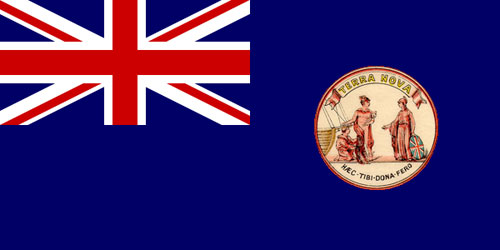Flag

1914 Map
Click on map for more detail
General facts
- Population: 250,000 (1914)
- Capital: St John’s (1914 population 30,000)
Government
- Head of State: King George V (6 May 1910 – 20 January 1936)
- Head of Government:
- Prime Minister Edward Morris (2 March 1909 – 31 December 1917)
- Prime Minister William Lloyd (5 January 1918 – 22 May 1919)
- Prime Minister Michael Cashin (22 May – 17 November 1919)
- Prime Minister Richard Squires (17 November 1919 – 24 July 1923)
Participation in the War
- Entered the war: 4 August 1914 (British Empire declared war on Germany)
- Ceased hostilities: 11 November 1918 (armistice with Germany)
- Ended belligerent status: 10 August 1920 (Treaty of Sèvres signed with Ottoman Empire)
Military Forces
Royal Naval Reserve Force
- Peacetime strength 1914: 565
Fleet (1914)
- Training sloops: 1 (HMS Briton)
- Total mobilised during the war: 1964
The Royal Newfoundland Regiment
- Total mobilised during the war: 6339
- Total sent overseas: 4984
Immediately after the declaration of war against Germany the Newfoundland government offered to raise an infantry regiment to serve overseas alongside British imperial troops. The British government accepted the offer and voluntary recruitment for the ‘Newfoundland Regiment’ began on 12 August 1914. The regiment served at Gallipoli in 1915 and on the Western Front from 1916 to 1918.
Newfoundland and Anzac Day
The Newfoundland Regiment was the only unit from North America to fight on Gallipoli. To mark its role in the campaign the Newfoundland Regiment commemorates Anzac Day, a unique tradition in the modern-day Canadian Forces. Every 25 April the regiment marches through St John’s to the National War Memorial where wreaths are laid and an official ceremony takes place. New Zealand and Australian military representatives from the High Commissions in Ottawa are invited to take part.
On 18 December 1917 King George V granted the Newfoundland Regiment the use of the prefix ‘Royal’ in its title. The Royal Newfoundland Regiment was the only regiment or corps in the entire British, Dominion and Indian armies to be awarded this prefix while the war was still being fought.
The Newfoundland Forestry Battalion
In early 1917 the Newfoundland government raised a forestry battalion of 500 men from volunteers who had been classed as unfit or too old for front-line combat service.
The battalion was sent to Scotland where it worked on the pine plantations of the Duke of Atholl’s estate near Perth producing lumber for the war effort until it returned to Newfoundland in 1919.
Conscription
- Introduced: 11 May 1918
- Total conscripted by end of war: 3629
- Total number of conscripts sent overseas by the end of the war: 1573
The Military Service Act was passed by the wartime National government of Prime Minister William Lloyd. This was a fragile coalition of the People’s Party, the Fishermen’s Protective Union and the Liberal Party.
All single men aged between 19 and 39 became liable for compulsory military service in the Royal Newfoundland Regiment. Only those deemed medically unfit for overseas service or officially recognised as conscientious objectors were granted exemptions. None of the conscripts sent overseas had completed their training in the United Kingdom when the war ended.
Casualties
The Royal Newfoundland Regiment
- Dead (all causes): 1240
- Wounded: 2314
- Total casaulties: 3554
Royal Naval Reserve Force
- Dead (all causes): 179
Total Casualties
- Dead (all causes): 1,419
- Wounded: 2,314
- Total casualties: 3,733
The 1st Battalion, The Newfoundland Regiment, was the only Dominion unit to fight on the first day of the Battle of the Somme, 1 July 1916, when the British Army suffered its highest losses ever in a single day’s fighting: 57,000 casualties, including 20,000 dead. The Newfoundlanders were assigned to the second wave of the British attack on the German trenches in the Beaumont-Hamel sector of the line. The attack failed and the Battalion was cut to pieces – of the 801 Newfoundlanders who took part in the assault, 710 were killed, wounded or missing by day’s end. The scale of this loss was unprecedented in the history of Newfoundland’s small and tight-knit community, and thereafter 1 July was commemorated annually as Memorial Day in the tiny dominion. This practice continues, even though Newfoundland officially gave up its dominion status to become Canada’s tenth province in 1949.
Private Thomas Ricketts VC
Western Front, 14 October 1918: Private Thomas Ricketts, 1st Battalion, The Royal Newfoundland Regiment, volunteers to join his section leader in an attempt to outflank and knock out a battery of German field guns which have opened fire at point-blank range on Ricketts’ platoon, inflicting heavy casualties. Having run out of ammunition for his Lewis gun during his initial assault on the German position, Ricketts re-crosses the exposed ground to retrieve more and resumes his attack, eventually forcing the Germans to abandon their guns, which are then captured by the rest of his platoon without any further casualties. For these actions Ricketts becomes the first soldier of the Royal Newfoundland Regiment to be awarded the Victoria Cross. Aged just 17 at the time of the action, Ricketts is the youngest soldier ever to receive the award. Born on 15 April 1901, he falsified his age to enlist.
